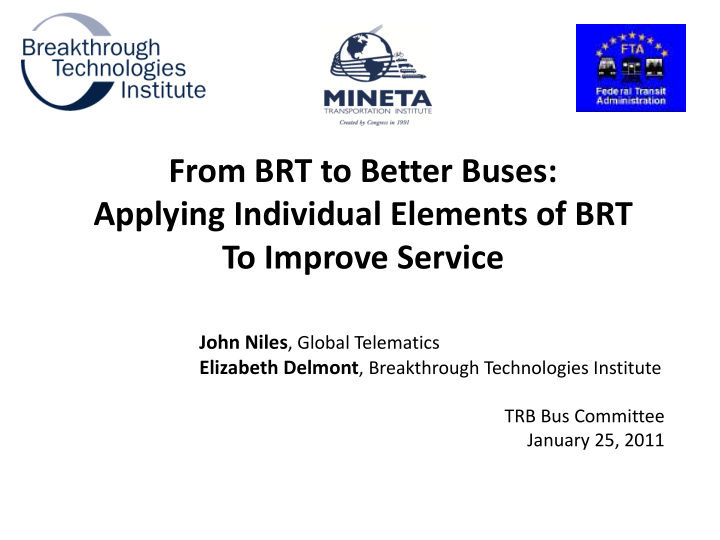



From BRT to Better Buses: Applying Individual Elements of BRT To Improve Service John Niles , Global Telematics Elizabeth Delmont , Breakthrough Technologies Institute TRB Bus Committee January 25, 2011
Phase One Study • Funded by Mineta Transportation Institute • Examined five BRT implementations • Ranged from light to heavy • Framed “incremental BRT” for bus service improvement network wide Posted at http://www.bettertransport.info/brt 2
BRT is Incremental Already “BRT systems should be capable of early action and amenable to staged (incremental) development .” TCRP REPORT 90 Bus Rapid Transit Volume 2: Implementation Guidelines, Chapter 2, Planning Principles “Elements of the BRT system may be added incrementally as funding or staff support is available .” BRT Information Clearinghouse 3
The Two Dimension of Incremental BRT Geographic deployment Tri-Met Frequent Bogota Transit Network – Network wide Transmilenio Not BRT, but has BRT York, Ontario Element. LA County VIVA Metro Rapid Multiple corridors Lane County, LA County Single corridor San Jose VTA 522 Oregon EMX Orange Line Frequent Buses Arterial Rapid Bus Dedicated Bus Lanes Light to Heavy with BRT elements & characteristics 5
6
Incremental BRT Concept Expanded • In addition to BRT as a new mode, consider it as defining a portfolio of many elements available to improve a bus network. • Focus on overall network performance instead of single corridor optimization. • Applying a few BRT elements widely does not necessarily mean evolving to more train-like. 7
BRT Elements Available for All Routes • Off-coach fare payment • Attractive, comfortable shelters for waiting customers • Low-floor level loading • Enhanced comfort on new coaches • Fuel-efficient, low-emission propulsion • Branding or color coding to differentiate routes • Centralized management of bus locations & headways • Bus priority at traffic signals • Real-time information to customers • Visible safety and security features 8
Phase Two: Quantifying the Benefits from Bus Rapid Transit Elements FTA Sponsored • Objective: Provide guidance on which BRT elements appear to have the greatest impact on bus route time. 9
Thanks to agencies for data! • Los Angeles, Orange Line and Metro Rapid • King County • TransLink, Vancouver British Columbia • Chicago Transit Authority • Washington, DC., WMATA • Las Vegas, MAX • Eugene, EmX • Kansas City, MAX • York Region, VIVA 10
Summary Results Characteristic Effect Confidence Level Station density 1.4 - 2.2 minute increase in route time per station 95% in all six data (Stations per mile) added per mile sets Use of low floor buses 8.2 – 9.8 minute decrease in route time where fleets 95% in four of the consist of all low floor buses six data sets 6.1 – 7.0 minute increase in route time where no 95% in two of the Dedicated bus lanes dedicated bus lanes are used compared with a high six data sets level of dedicated bus lanes Varied across data sets and levels of TSP density, 95% in three of the Transit signal priority showing both increases and decreases in route time six data sets 95% confident in one 0.7 – 11.8 minute increase in route time for one Number of boarding data set; 90% doors boarding door compared with two boarding doors confident in another data set 11
Example: Station Density • Sample included station densities from one to seven stations per mile, with a high of 11 and low of 0.80. • All data sets found positive relationship between decreased station density and speed • 1.4 to 2.2 minute increase in total route time per added station • Tradeoff between speeding up a route and the walkable convenience of transit access for customers 12
Example: Transit Signal Priority • Four categorical variables – “high,” “medium,” “low,” and “none.” • Effects varied across datasets and levels of TSP – Presence of TSP was correlated with both increases and decreases in route time • Consistent with literature – E.g., Las Vegas, TriMet 13
Conclusion • Benefits of BRT elements are measurable when available, assembled, and analyzed. • Individual BRT elements can provide improvements to existing routes even when implemented on non BRT routes • Affordable network-wide bus performance improvements both visible to customers and efficiency enhancing more important than ever. 14
Both reports at http://www.bettertransport.info/brt John Niles Email: niles@globaltelematics.com Phone: 206-781-4475 Elizabeth Delmont Email: elizabeth@fuelcells.org Phone: 202-785-4222, ext. 31 15
Recommend
More recommend